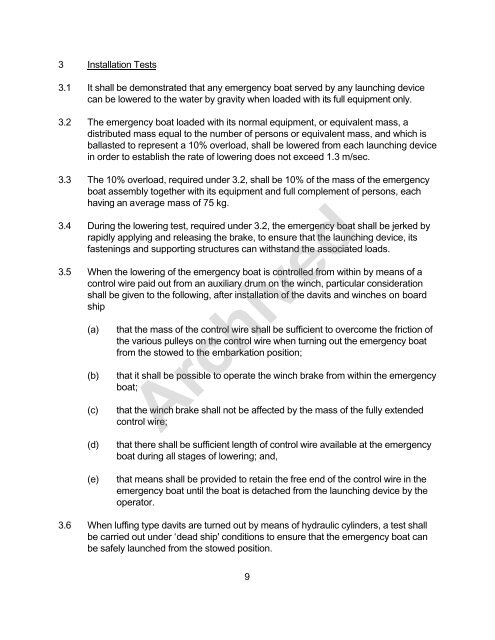LAUNCHING and EMBARKATION APPLIANCES TP 7323(E ...
LAUNCHING and EMBARKATION APPLIANCES TP 7323(E ...
LAUNCHING and EMBARKATION APPLIANCES TP 7323(E ...
You also want an ePaper? Increase the reach of your titles
YUMPU automatically turns print PDFs into web optimized ePapers that Google loves.
3 Installation Tests<br />
3.1 It shall be demonstrated that any emergency boat served by any launching device<br />
can be lowered to the water by gravity when loaded with its full equipment only.<br />
3.2 The emergency boat loaded with its normal equipment, or equivalent mass, a<br />
distributed mass equal to the number of persons or equivalent mass, <strong>and</strong> which is<br />
ballasted to represent a 10% overload, shall be lowered from each launching device<br />
in order to establish the rate of lowering does not exceed 1.3 m/sec.<br />
3.3 The 10% overload, required under 3.2, shall be 10% of the mass of the emergency<br />
boat assembly together with its equipment <strong>and</strong> full complement of persons, each<br />
having an average mass of 75 kg.<br />
3.4 During the lowering test, required under 3.2, the emergency boat shall be jerked by<br />
rapidly applying <strong>and</strong> releasing the brake, to ensure that the launching device, its<br />
fastenings <strong>and</strong> supporting structures can withst<strong>and</strong> the associated loads.<br />
3.5 When the lowering of the emergency boat is controlled from within by means of a<br />
control wire paid out from an auxiliary drum on the winch, particular consideration<br />
shall be given to the following, after installation of the davits <strong>and</strong> winches on board<br />
ship<br />
(a)<br />
(b)<br />
(c)<br />
(d)<br />
that the mass of the control wire shall be sufficient to overcome the friction of<br />
the various pulleys on the control wire when turning out the emergency boat<br />
from the stowed to the embarkation position;<br />
that it shall be possible to operate the winch brake from within the emergency<br />
boat;<br />
Archived<br />
that the winch brake shall not be affected by the mass of the fully extended<br />
control wire;<br />
that there shall be sufficient length of control wire available at the emergency<br />
boat during all stages of lowering; <strong>and</strong>,<br />
(e)<br />
that means shall be provided to retain the free end of the control wire in the<br />
emergency boat until the boat is detached from the launching device by the<br />
operator.<br />
3.6 When luffing type davits are turned out by means of hydraulic cylinders, a test shall<br />
be carried out under ‘dead ship' conditions to ensure that the emergency boat can<br />
be safely launched from the stowed position.<br />
9
















